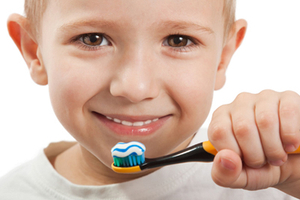
Pediatric dentistry

Child’s first visit to a dentist can be done before the emergence of a single tooth. On that occasion, parents will get information on proper eating habits, as well as maintenance of oral hygiene in the earliest age. Refined, soft food, rich in charcoal hydrates favors the formation of caries on otherwise sensitive baby teeth and thereby disables normal nutrition and development in children.
 The growth of baby teeth ends up to the third year of life and by then the child should have ten teeth in each jaw (a total of twenty in both). Of course, sometimes there may be deviations in the sense of earlier or later tooth enhancement, although this does not necessarily imply the existence of irregularities in tooth enhancement. Dentist will follow the occlusion development and will notice if any irregularities occur in the development.
The growth of baby teeth ends up to the third year of life and by then the child should have ten teeth in each jaw (a total of twenty in both). Of course, sometimes there may be deviations in the sense of earlier or later tooth enhancement, although this does not necessarily imply the existence of irregularities in tooth enhancement. Dentist will follow the occlusion development and will notice if any irregularities occur in the development.
Why do the baby teeth need to be repaired if permanent teeth will replace them at one point?
Milk teeth should be repaired as soon as caries occur and thereby preventing spreading of the disease to deeper tooth tissue (dentin, pulp) and on the bone. Children, like adults, are sensitive to the pain and they should be provided with the possibility of normal nutrition and chewing. The existence of cavities on proximal (lateral) surfaces of milk teeth, induces food retention in existing defects (cavities), inflammation of the gums in that region of the teeth, pain, avoiding chewing on both sides. There is also a reduction in space for placing of future permanent teeth, and with the loss of baby teeth, these areas can be completely lost and cause the orthodontic anomaly. The presence of baby teeth is also necessary for the normal development of the jaw. Today there is a large selection of filling materials on the milk teeth and, wherever possible, they need to be repaired to prevent further complications.
What is circular caries?
Circular caries is a specific form of caries, which occurs on milk teeth, in children, most often due to the frequent and long use of bottles with milk, water, juices. Long-term presence of sugar in the mouth, and in the presence of plaque bacteria, leads to an acid formation, which erodes tooth enamel and leads to the creation of recognizable white spots, first on the upper incisors, right next to the gums, and later to the other teeth. In time, these stains further pigment spread and merge. Further, there is the formation of cavities (defects) on tooth enamel. The cavities extend to deeper dental tissues, and the teeth remain weak, brittle and easily broken. Often only residual teeth roots can be seen. Symptoms (pain, swelling, fistula) occur only later when the process is spread to the bone. The consequences of circular caries are malnutrition, problems with pronunciation, a disorder in the development of permanent teeth, lack of space for permanent teeth, orthodontic anomalies.
Therapy of circular caries
The most important is the regular dental visits and controls. As soon as the appearance of white stains is detected, it should be started with the application of preparations based on fluorine, both in the ordination and at home, daily. The dentist will recommend preparations of a certain concentration. For existing cavities, it is necessary to repair the teeth with fillings and prevent further spread of caries. When the condition of the teeth is such that it is impossible to take care of them by standard conservative methods, it is accessed to an extraction of residual roots and later dental restorations, and if necessary, making of a space keeper.
 In addition to chewing, milk teeth are also important for facial esthetics, and it should not be neglected just because these teeth will be replaced with permanent teeth. Also, they participate in the normal speech development of the child. These are also important facts in the normal sociological development of children.
In addition to chewing, milk teeth are also important for facial esthetics, and it should not be neglected just because these teeth will be replaced with permanent teeth. Also, they participate in the normal speech development of the child. These are also important facts in the normal sociological development of children.
In addition to milk teeth, in the child’s age around the sixth year, the emergence of permanent teeth begins. The most common tooth, on which caries can be observed, is the first permanent molar (“six-year molars“). It emerges before all other permanent posterior teeth, so in fact, its life in the mouth is the longest. It has a well-developed jam and fissure system on its biting surface, therefore, if it is not sealed on time with the appropriate fissure sealant, is often affected by caries. In the event of a caries appearance, it is necessary to repair it with the fillings and in that way ensure its stay in the oral cavity. This is especially important because the first permanent molar is considered the “key” of the normal development of the bite.
Teeth injuries in children
Teeth injuries are most common in children. In a large number of cases, the front teeth, often the upper ones, are damaged. Milk or permanent teeth can be affected. The fractures can be of varying degrees from the smallest cracks of tooth enamel to fracture with exposed tooth pulp, fracture of the tooth root, displacement of a tooth from alveolar bone or damaging permanent tooth-germ. Even soft tissue injuries are common. Whether there are any signs of injury (pain, swelling, tooth swinging) or not, it is necessary to consult a dentist as soon as possible, for controlling and making the required X-ray images.
Fractured (broken) teeth can most often be successfully compensated with a large selection of esthetic materials and therefore completely restore aesthetics and function.
Injuries are most commonly found in protruded teeth (protrusion of the teeth due to bad habits, orthodontic anomalies, etc.), so it is necessary to think about it in time for correcting orthodontic anomalies. For children who are engaged in sports, there is a large number of shields (“mouth guard”), which mechanically protect the teeth and surrounding soft and hard tissue from injury.
